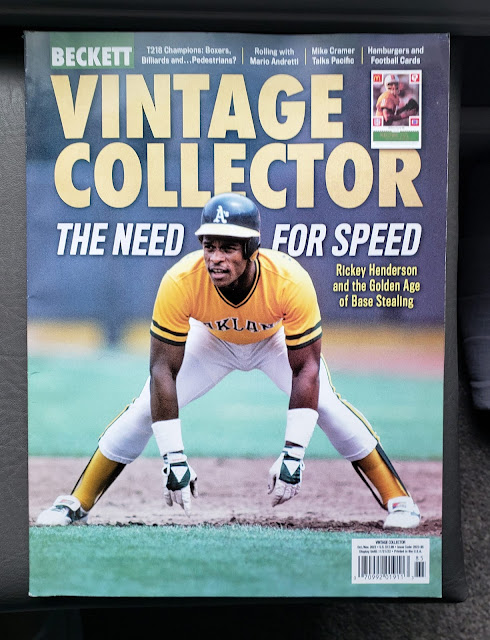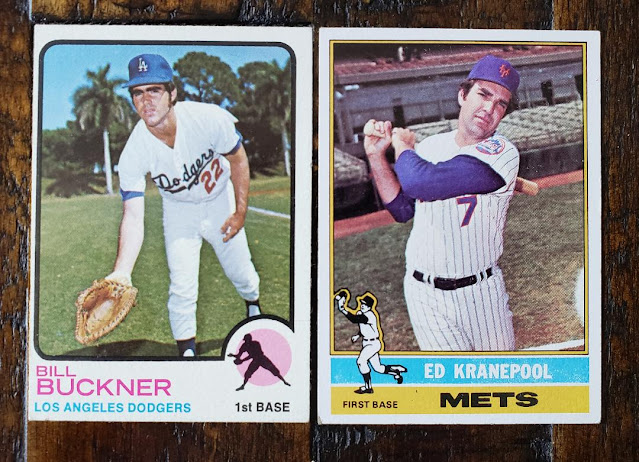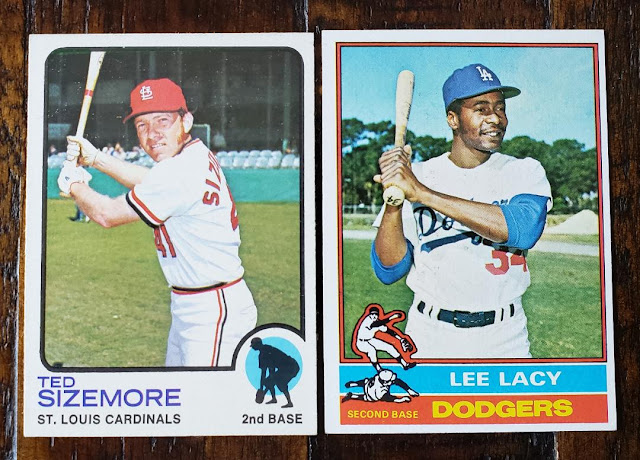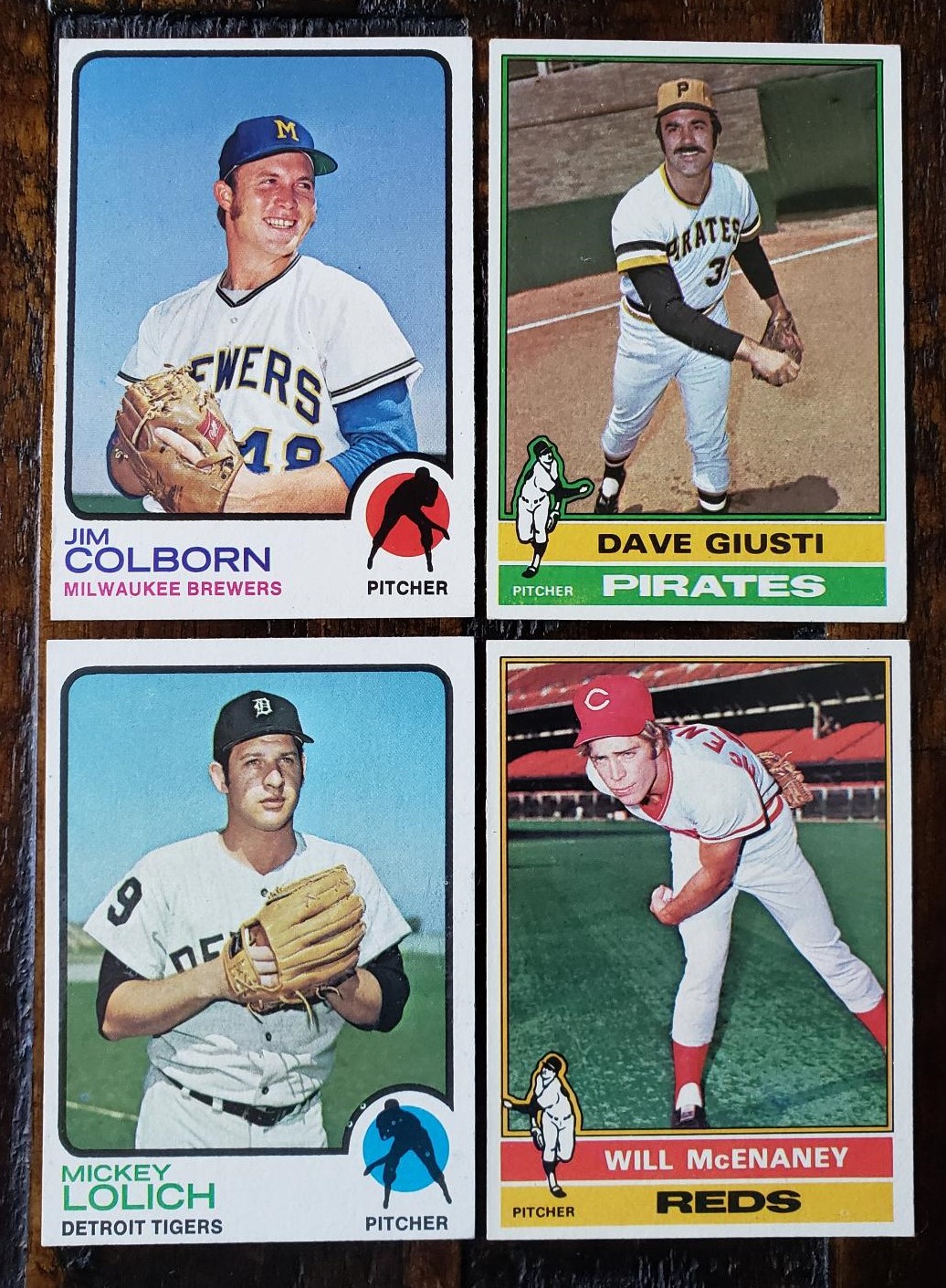So, the October/November issue of Beckett Vintage Collector appeared in my mailbox on Saturday, right before I headed out the door for a few days.
As mentioned earlier, the issue's arrival was delayed almost a month. I'm assuming it was mail or distribution problems, but no matter, it's here now.
I wanted to see if one or both of the articles I had most recently written were in this issue, with the terrific Rickey Henderson cover. One of them was. And I was informed that the other one will show up in the December/January issue.
This is the 17th article I've written for Beckett. I'm mostly impressed that I can still come up with topics. Who knows how long that will last. This most recent topic is one I've written about on the blog many times, and others have covered this set quite a bit, too.
It's been 50 years since Topps released the 1973 Topps baseball set, much-discussed in blog circles (I mentioned that in the article). So when I got the green light to do the story, I searched for a different way to approach it. I just couldn't rehash the same old airbrushing stories, etc., at least not make that the focus of the story.
I decided to see if I could talk to some collectors who worked on that set back in 1973, and I was lucky enough to find a couple of blog readers who were willing to give their thoughts. You may know them from the comments. Both "1984 Tigers" and "Doc Samson" were gracious enough to relay their thoughts and experiences with '73 Topps. And that's what made this article.
A portion of the article is about that final-series checklist, which I wrote more than one blog post about when I was tackling the set. It's been a sticking point for decades, apparently, which I found out when doing the story.
It was nice hearing those childhood experiences with the '73 set. I didn't collect that set as a kid, I was still a year or two away from being interested in cards. And it took me years and years to appreciate what this set means to so many. (But I also made sure to cover the good and "bad").
I always try to cover on the blog something related to whatever magazine article I've just written, but I'm pretty much tapped out on '73 Topps. About all I can think of is a throw-away post on the position graphics in '73.
My first experience with the little position guys on Topps cards was not with '73 Topps but with '76 Topps. I recall seeing the '73 cards for the first time and thinking "what, they already DID this?" Because I saw '76 first, I have an allegiance to those drawings, but the '73s came first so those deserve credit.
How about if I pit them against each other to see which is the Supreme Position Drawing Of The '70s?
Sounds good to me.
FIRST BASE
If you're not a fan of silhouettes, you're going to vote for '76 every time, but I'll ignore that and go with what's being illustrated. You can see the '76 first baseman catching the ball, that's cool, but his right foot doesn't seem to be anywhere near the bag.
✓ 1973 Topps
SECOND BASE
The '73 second baseman is casually fielding a grounder. The '76 drawing is much more action-packed with the second baseman leaping above a sliding base-runner in a bid to complete the double play.
✓ 1976 Topps
SHORTSTOP
Again, the '73 infielder is securing a grounder while the '76 infielder is directly engaged with a base-runner, this one seems like a stolen-base attempt.
✓ 1976 Topps
THIRD BASE
I've always liked the '76 third base drawing but he doesn't seem to be doing a heck of a lot, maybe waiting for a throw from the outfield. The '73 third baseman seems to be channeling Brooks Robinson, which would be time-appropriate in '73.
✓ 1973 Topps
OUTFIELD
As a kid, I thought the '76 outfielder was waving. I didn't know what was going on. There is definitely a bit of style with the '76 guy as he glides back for a fly ball. The '73 looks like a lunging stab of a shot that was almost past him. I've seen that like six times in the postseason already. '73 gets the slight edge.
✓ 1973 Topps
CATCHER
I've always liked the '73 catcher pose, though not sure when a mitt arm stretched out that far wouldn't interfere with the batter. Maybe he's just setting a target for his pitcher. The '76 catcher is a bit casual.
✓ 1973 Topps
PITCHER
Full credit for both '73 and '76 using different drawings for right- and left-handed pitchers. The '73 is a classic wind-up finish. The '76s I've never understood. Maybe if the pitcher threw underhand, this would make sense. Or maybe he's shoveling the ball to first base after picking up a short grounder? Anyway ...
✓ 1973 Topps
1973 Topps wins it 5-2, though I love those '76 middle infielder icons.
1976 also had a designated hitter position guy, but there was none of that in '73 at the dawn of the DH, so there's nothing to compare.
So, that, maybe, is my last dedication to 1973 Topps. I think I've run out of things to say, but you know how that goes when it comes to cards.

.jpg)








Comments
Back in the early 90s, a local card store owner and I struck up a friendship and loved talking cards. I remember him buying a 1973 opc Schmidt rookie. He showed me the card. Someone had used a pen on the back side to cover over the opc logo. Told him that probably dropped the value by 90 percent. A Schmidt opc would have been expensive enough at the time.
I like the 76 set but it didn't have the same pull on me at the time as the 75 minis did in Detroit.
Has beckett vintage done any articles in the past few years about the early 60s Post cereal sets. Or the 60 or 61 fleer all time greats sets?
Those two became an interest to me about 20 years ago. Put together a full 60 fleer set and mostly full sets of 61F and 61 to 63 post sets. Then had to start putting the excess money into a college fund so never finished them.